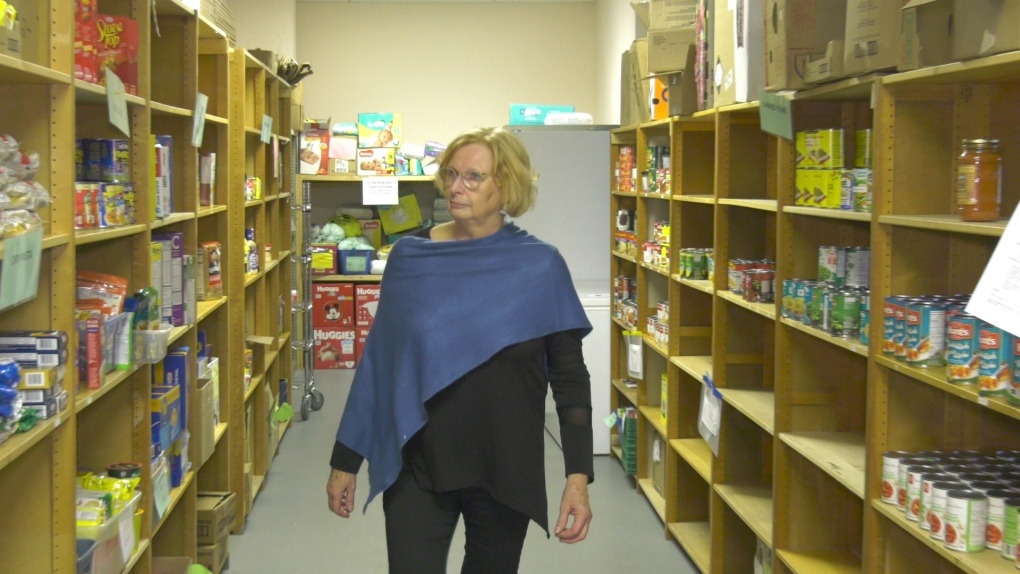Increase in food bank use in Ontario also seen in rural areas
The latest Hunger Report from Feed Ontario shows more Ontarians are relying on food banks and visiting them more often.
And it’s a trend happening in rural regions as well, with less affordable housing playing a key factor.
Representatives from Feed Ontario provided an update on the report in Morrisburg on Friday, with Food Banks United, an eastern Ontario food bank collaborative, also discussing what is happening rurally.
"The biggest issue is affordable housing due to COVID," said Jane Schoones, Dundas & Stormont Community Food Share Lead. "Many people were displaced because a lot of folk realized they could move to this part of the province and they could work from home."
Rent went up for some while others were evicted as housing prices soared, Schoones said.
Experts say there is clear evidence the increase in demand for food banks is directly connected to a lack of affordable housing.
"We have a lot of people that have moved out of the area simply because they couldn't afford to live rurally anymore," Schoones said. "Numbers have gone up between 40 and 45 per cent throughout the rural area."
Highlights from the annual hunger report show people who are employed are accessing food banks more, increasing by 47 per cent since 2018. Between January and September 2022, food bank visitors increased by 24 per cent over the past year.
The number of first time food bank users has increased by 64 per cent over pre-pandemic levels, and food bank use remains at an all time high, with 2022 marking the sixth consecutive year of increase.
"There is not enough money at the end of the month, particularly with gas going up, the rent's going up, so groceries are usually on the bottom of the list," Schoones said. "It's hard. Groceries are so expensive, they can't afford fresh fruit, they cannot afford meat. It's just difficult."
 Ashley Quan from Feed Ontario highlights some of the numbers from the 2022 Hunger Report in Morrisburg, Ont. Dec. 9, 2022. (Nate Vandermeer/CTV News Ottawa)
Ashley Quan from Feed Ontario highlights some of the numbers from the 2022 Hunger Report in Morrisburg, Ont. Dec. 9, 2022. (Nate Vandermeer/CTV News Ottawa)
Ashley Quan, of Feed Ontario, says the group anticipated the higher numbers.
"We didn't know inflation was going to hit people this hard," Quan said. "But we knew that people have become less economically resilient over time, and haven't been able to weather storms as easily."
She noted affordable housing is not just a problem related to the larger cities.
"We've seen that unaffordable housing is not just a Greater Toronto Area problem, it is a problem across the entire province," she said. "All of our food banks are seeing that unaffordable housing is an issue and we saw actually the greatest spikes in housing affordability were outside of the GTA over the past few years."
Quan also says while the report showed people have a harder time escaping poverty now than they did 30 years ago, they also included a blueprint on how food bank use and housing affordability can be turned around.
"Two thirds of the people who use food banks rely on provincial social assistance and we've seen that those numbers, those rates, the support that’s provided, has been frozen for the past four years," Quan said, while noting there's been a slight increase this year for ODSP.
"The amount provided has been static while the cost of living has increased, so putting investments into those programs is a great initial first step."
Qaun says supports like employment insurance, Ontario Works and ODSP have also become more difficult to access, or provided less support than they did before.
"We've seen what greater investments in social housing, greater investments in social assistance, greater investments in employment insurance can do to reduce the need for food banks, to help people get out of poverty," she added.
"We're not re-inventing the wheel; that is something that we can turn to, to make things better."
Schoones also noted living in rural areas can be a challenge, with less transportation options for those who rely on food banks.
 Jane Schoones walks down an aisle at the Morrisburg Community Food Share. (Nate Vandermeer/CTV News Ottawa)
Jane Schoones walks down an aisle at the Morrisburg Community Food Share. (Nate Vandermeer/CTV News Ottawa)
"Transportation is a big issue because there is no bus to jump on and quite often clients have to count on each other for a ride and if that ride falls through, it's a difficult season for them," she said.
"In quite a few cases, people come in but they don't tell us what's going on in their lives," she added. "We have a great relationship, our volunteers and my staff that work at the food bank, wonderful relationship with people coming in, but it's still difficult on both sides of the coin."
"Food banks are here to help. We have food, come and see us. Don't be afraid," Schoones said.
The full Hunger Report from Feed Ontario can be found on their website.
CTVNews.ca Top Stories

Freeland to present 2024 federal budget, promising billions in new spending
Canadians will learn Tuesday the entirety of the federal Liberal government's new spending plans, and how they intend to pay for them, when Deputy Prime Minister and Finance Minister Chrystia Freeland tables the 2024 federal budget.
Ontario woman charged almost $7,000 for 20-minute taxi ride abroad
An Ontario woman was shocked to find she’d been charged nearly $7,000 after unknowingly using an unauthorized taxi company while on vacation in January.
Worker seriously injured after fall at Montreal Olympic Stadium
A man is fighting for his life after falling about 30 feet in an air duct at Montreal's Olympic Stadium on Monday, authorities say.
Tim Hortons launches pizza nationally to 'stretch the brand' to afternoon, night
Tim Hortons is launching flatbread pizzas nationally in a bid to pick up more afternoon and evening customers.
Despite weather glitch, the Paris Olympics flame is lit at the Greek cradle of ancient games
The flame that is to burn at the Paris Olympics was kindled Tuesday at the site of the ancient games in southern Greece.
Step inside Emma Roberts' sumptuous L.A. home
While many celebrity homes look less than lived-in, ranging from spotless minimal to ostentatiously palatial, actor Emma Roberts' Hollywood Hills home is made for curling up with a good book -- or several -- with warm tones, comfortable couches, and antique curiosities in each room (also, a lagoon-style pool in the backyard for summer reads).
NASA confirms mystery object that crashed through roof of Florida home came from space station
NASA confirmed Monday that a mystery object that crashed through the roof of a Florida home last month was a chunk of space junk from equipment discarded at the International Space Station.
Hazard ahead: Are cuts at Tesla a warning sign for the EV market in Canada?
Tesla has hit a series of roadblocks, including increased competition and declining sales. The company announced Monday it is slashing 10 per cent of its global workforce.
Fire rages through the 17th-century Old Stock Exchange in Copenhagen, toppling the iconic spire
A fire raged through one of Copenhagen's oldest buildings on Tuesday, causing the collapse of the iconic spire from the 17th-century Old Stock Exchange as passersby rushed to help emergency services save priceless paintings and other valuables.






























